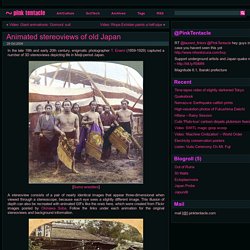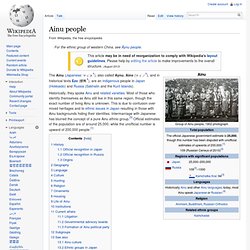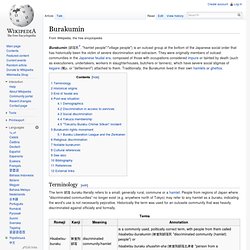

Animated stereoviews of old Japan. 28 Oct 2009 In the late 19th and early 20th century, enigmatic photographer T.

Enami (1859-1929) captured a number of 3D stereoviews depicting life in Meiji-period Japan. [Sumo wrestlers] A stereoview consists of a pair of nearly identical images that appear three-dimensional when viewed through a stereoscope, because each eye sees a slightly different image. This illusion of depth can also be recreated with animated GIFs like the ones here, which were created from Flickr images posted by Okinawa Soba. [Meeting at gate] [Buddhist ornament dealer] [Geisha washing their hands in the garden] [Chujenji Road, Nikko] [Geisha playing music] [Firewood dealers] [Great Buddha of Kamakura] [Torii gates at Inari shrine, Kyoto] [Geisha girls with flowers and cat]
Battleship Island - Japan's rotting metropolis. These days the only things that land on Hashima Island are the shits of passing seagulls.

An hour or so’s sail from the port of Nagasaki, the abandoned island silently crumbles. A former coal mining facility owned by Mitsubishi Motors, it was once the most densely populated place on earth, packing over 13,000 people into each square kilometre of its residential high-risers. It operated from 1887 until 1974, after which the coal industry fell into decline and the mines were shut for good.
With their jobs gone and no other reason to stay in this mini urban nightmare, almost overnight the entire population fled back to the mainland, leaving most of their stuff behind to rot. Today it is illegal to go anywhere near the place as it's beyond restoration and totally unsafe. The punishment for being caught visiting Hashima Island is 30 days in prison followed by immediate deportation. Ainu people. The Ainu (Japanese: アイヌ?)

, also called Aynu, Aino (アイノ?) , and in historical texts Ezo (蝦夷?) , are an indigenous people in Japan (Hokkaido) and Russia (Sakhalin and the Kuril Islands). Historically, they spoke Ainu and related varieties. Most of those who identify themselves as Ainu still live in this same region, though the exact number of living Ainu is unknown. History[edit] A group of Ainu people (between 1863 and early 1870s) Recent research suggests that Ainu culture originated in a merger of the Okhotsk and Satsumon cultures.[6] In 1264, Nivkh people reported to the Yuan Dynasty of China that Ainu invaded the land of Nivkh, resulting in battles between Ainu and the Yuan Dynasty.[7] Active contact between the Wajin (the ethnically Japanese) and the Ainu of Ezochi (now known as Hokkaido) began in the 13th century.[8] The Ainu formed a society of hunter-gatherers, living mainly by hunting and fishing, and the people followed a religion based on phenomena of nature.[9]
Burakumin. Terminology[edit] A widely used term for buraku settlements is dōwa chiku (同和地区 "assimilation districts"), an official term for districts designated for government and local authority assimilation projects.

The social issue surrounding "discriminated communities" is usually referred to as dōwa mondai (同和問題 "assimilation issues") or less commonly, buraku mondai (部落問題"hamlet issues"). In the feudal era, the outcaste were called eta (穢多, literally, "an abundance of defilement" or "an abundance of filth"), a term now obviously considered derogatory. Eta towns were called etamura (穢多村). Some burakumin refer to their own communities as "mura" (村 "villages") and themselves as "mura-no-mono" (村の者 "village people"). Other outcaste groups from whom Buraku may have been descended included the hinin (非人—literally "non-human"). In the 19th century the umbrella term burakumin was coined to name the eta and hinin because both classes were forced to live in separate village neighborhoods.[1]
Proletarian posters from 1930s Japan. In the 1930s, a new style of poster emerged that reflected the growing significance of the masses in Japanese society.

These artistic posters borrowed elements from Western design and often incorporated bold slogans with political, economic and educational themes. Here are a few examples. Health Exercises for the People (Bureau of Postal Insurance, 1930) Tohoku Area Famine Relief (Federation of Tokyo Area Proletarian Organizations, 1931) The 2nd Proletarian Art Grand Exhibition (Japan Proletarian Artists Federation, 1929) Workers and Farmers Russian Art Exhibit (Japan Proletarian Art League, 1927) Listen! Safety Leads to Efficiency (Labor Welfare Association, 1932) Proletarian Art Institute (1930) Poster for The Proletarian Graph Magazine (Proletarian News Company, 1929) Indulging in Alcohol Ruins Your Health (Labor Welfare Association, 1932) Harufusa Ohashi (Election Poster for Labor-Farmer Party, 1928) Come, the Dawn of Mankind is Breaking (Farmers' Theater Performance, 1928) To Manchuria!
Japan. Japanese interests.